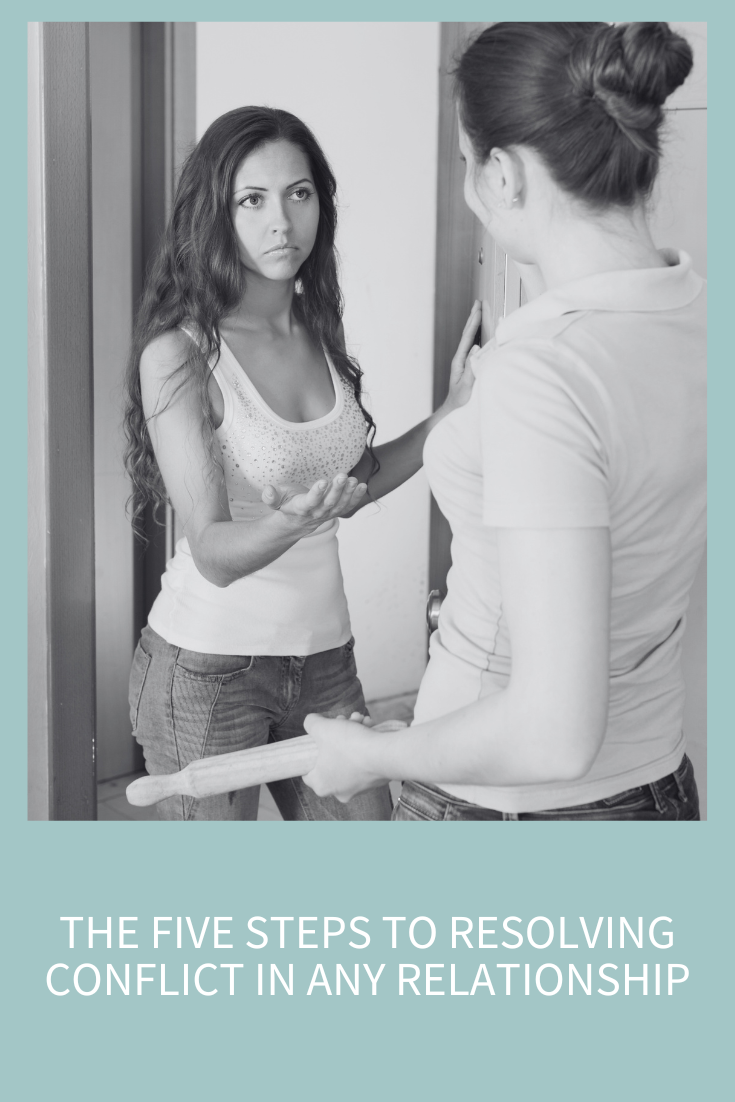
Conflicts in any relationship are inevitable. Whether it’s with a partner, friend, family member, or colleague, disagreements are going to happen as we all have different needs, perspectives, and boundaries. I’ve noticed that conflict avoidance has become a bigger and bigger problem since the pandemic, and I’m here to tell you: it’s quietly wrecking your mental health and eating away at the foundation of all your relationships. It’s time to see conflict as an opportunity, not a problem. It’s time to engage instead of running away. It’s time to be happier and more connected in all your relationships by learning the five steps to resolving conflict in any relationship.
9-minute read
Introduction
As I said, avoiding conflict is like allowing termites in the foundation of your relationships. Unresolved conflict can lead to more stress, emotional strain, and even physical health risks. And we know that people who avoid conflict are more likely to experience long-term dissatisfaction in their relationships, which means more resentment and disengagement.
Instead of avoiding conflict, it’s time to learn how to resolve it effectively so you can deepen connections and raise your sense of self-worth and well-being. Studies have shown that people who manage conflict well tend to experience more fulfilling relationships and report lower stress levels, and it’s time for that person to be you! In fact, according to the research, disagreement in any type of relationship can create deeper understanding and growth.
History of Conflict Resolution Frameworks
There are some main conflict resolution frameworks that I want to touch on because I’ve incorporated pieces of each one in my steps (and you know I always want to let you know that my tips are research-based).
I. Active Listening
You could argue that active listening is the foundation of any and all effective communication. Developed by psychologist Carl Rogers, active listening requires us to listen not just with our ears but with full presence, showing genuine interest in the other person’s perspective. Research has shown that active listening can help de-escalate conflict by demonstrating empathy and understanding, which in turn encourages the other party to lower their guard and engage in open dialogue.
So, let’s say you’re having a conflict with a friend. Instead of jumping in with your own perspective, try repeating back what you heard your friend say, then ask, “Did I get that right?” This small action can validate their feelings and build a foundation for understanding.
II. Nonviolent Communication (NVC)
Developed by psychologist Marshall Rosenberg, Nonviolent Communication (NVC) is a framework that emphasizes empathy, clarity, and respect. The key elements involve observing without judgment, identifying feelings, expressing needs, and making clear, respectful requests. Studies show that NVC can help reduce workplace conflicts and improve family relationships by facilitating honest yet kind communication.
Let’s say you’re in a disagreement with your brother. Instead of accusing him of being “selfish,” you might say, “When you borrowed my car without asking, I felt frustrated because I need to plan for my own transportation. In the future, could you ask me first?”
III. Emotional Validation
Emotional validation, particularly researched by John Gottman, underscores the importance of acknowledging the other person’s feelings without immediately offering solutions or criticisms. Gottman’s studies, especially in romantic relationships, show that couples who practice validation during conflict are more likely to feel close and satisfied in their relationships. Validating someone’s emotions doesn’t mean you agree with them; it just shows you recognize their perspective.
Here’s how you use it: In a workplace conflict, you might say, “I can see that this project means a lot to you and that you feel strongly about it.” This allows your colleague to feel heard and valued, which can pave the way for a more constructive conversation about differing opinions. Or if you’re arguing with your partner, you might say: “I can see how upset you are. I get that you’re angry and not feeling heard.”
IV. Reframing and Perspective-Taking
Reframing is about shifting your mindset to view conflict as an “us vs. the problem” scenario rather than a “me vs. you” one. Research on perspective-taking shows that when we try to understand the other person’s viewpoint, it can reduce biases and enhance empathy. So, if you’re in a conflict with your partner, rather than viewing the argument as a sign of the relationship weakening, you might reframe it as an opportunity to understand each other’s needs and preferences better, ultimately strengthening your bond.
The Five Steps to Conflict Resolution
I think we can all agree that the key to healthy conflict in a relationship is its resolution. To me, this means that there’s no lingering hostility, frustration, or resentment on either side, and that’s often difficult to accomplish. But you can get there with these five steps.
Step One: Agree on the Five Agreements
I would encourage you to say these out loud to one another or even post them somewhere so you come back to these agreements. These need to be agreed upon verbally before jumping in.
- You have to agree to a win-win mindset going in. It’s not, “How can I make the other person agree with what I want?” It’s, “How can we get to a resolution we both agree to?”
- Start the conversation looking to learn something, not prove something. This is where active listening really comes in. You’re agreeing, upfront, that you want to listen to understand, not to rebut.
- Set a time to discuss this issue. Do not speak late at night when you’re both exhausted. Better to go to bed angry than to say more things which can irreparably damage the relationship and create more issues. Also, most people wake up less angry, so conversations go better. Also, don’t speak for hours. Set aside an hour and accomplish what you can in that time.
- Stay solution focused on only this issue. Shift from blame to solutions. Don’t bring up other issues related to this one. Don’t go tit for tat: “Well, this might be bothering you, but what about what’s bothering me?!”
- No labeling the other person. Do not call them selfish, bipolar, or even angry.
Step Two: Focus on Yourself, Not Them
In his book Getting to Yes with Yourself, Harvard Negotiation Project cofounder William Ury says that our biggest obstacle in any negotiation is ourselves. I know you want to blame timing, your partner, your dog or your lack of power, but it’s really you that gets in the way of your success the most.
He writes, “We sabotage ourselves by reacting in ways that do not serve our true interests.” We can all relate to reverting to old patterns and behaviors when we’re trying to resolve a conflict as we act defensively, lose our temper, say yes when we mean no, or withdraw instead of asserting ourselves. We get angry or impatient, which leads us to make choices and concessions we regret later on.
Learning to be more self-aware and understand our unhealthy patterns and cycles is the first step to making them stop. If you keep doing what you’ve always done, you’re going to get what you’ve always got. It’s time to work on your self-awareness and to diligently work on raising your emotional intelligence and emotional regulation.
It’s crucial to note how you’re feeling and get yourself to a good-feeling place before you have any conversation where you’re trying to resolve conflict!
Step Three: State Intentions First
You’ve got to start with setting a conscious intention or goal of being curious. I talk a lot about setting intention and getting yourself ready for these types of conversations. You’ve got to spend some time beforehand getting yourself into that good-feeling place. Don’t go in anxious or worried! The other person will pick up on that, and you’ll be screwed before you start. Instead, focus on how you want that conversation to go, not what you’re afraid might happen.
- It’s my intention to listen to my friend with an open mind and an open heart.
- It’s my intention that my coworker will feel heard and understood.
- It’s my intention that my partner and I will both walk away from this conversation feeling more connected.
- It’s my intention to stay mindful throughout this conversation and notice any unwanted feelings
- It’s my intention to focus on being patient and asking questions instead of making statements
Step Four: Change the Paradigm
Negotiations are generally set up along a straight line, and that’s where the problems begin. You’re at point A on the line, and the other person is at the other end, at point B. You’re trying to come to some agreement “in the middle” along this imaginary line, and you end up in a tug-of-war as you try to pull them towards your way of thinking, and they try to pull you over towards their ideas of what’s right.
We naturally resist because we don’t want to lose! It’s time to go into any decisions or discussions with a new paradigm: negotiating and coming to consensus is a triangle, not a line. Think of you and the other person still as point A and point B, but now you’re at the base points of a triangle instead of a line. The consensus point is up there at point C on the top of the triangle!
You’re going to come up with a new idea together that neither of you had thought of before. You’re going to approach this as neither of you being right but, instead, as a discovery and brainstorming mission. Neither of you knows yet where it might end up but point C is something you both buy into. Even if you end up deciding on “your way” or the other person’s initial plan, this process of open inquiry and collaboration will ensure buy-in from both of you when it’s all said and done.
You know you’re brainstorming effectively when you come up with many more solutions or ideas than the two sides you started with. There are always many answers to any issue so make sure you’re allowing yourself the freedom to really expand your thinking and wonder.
Step Five: Ask Collaborative Questions
I’ve said this one often, you can’t SAC your relationships. Don’t make Suggestions, offer Advice or Criticize in this (or any) conversation. Instead, you’re going to be curious and ask collaborative questions with the intention of having a better understanding of what the other person wants and needs. What’s driving their thinking? What’s underneath what they’re saying they want? Try to stay away from “Why?” questions, which tend to put people on the defensive. You might start with questions like:
- Can you tell me more about X?
- Can you say more about why you feel so strongly about Y?
- What do you mean by X? Can you give me another example?
- What’s something I haven’t asked that would help move this conversation forward?
Grab my FREE List of Collaborative Questions!
In the end, make sure you’re not making or holding any assumptions about what the other person thinks or wants. You’re asking questions with curiosity; you’re not driving towards a conclusion.
Wrap Up
When you shift your own perspective so you can see (even embrace?) conflict as a growth opportunity instead of something scary, you’ll completely change the game. When approached thoughtfully, conflict can become an avenue for growth rather than a source of stress. These strategies empower us to engage with each other in healthier, more compassionate ways, building relationships based on respect, empathy, and understanding. Whether in romance, friendships, family, or professional settings, learning to manage conflict effectively is an essential skill that can elevate all our relationships.
Other episodes that will help you with conflict resolution:
The Five Steps to Effective Negotiation In All Your Relationships
Resources for The Five Steps to Resolving Conflict in Any Relationship
The Five Steps to Effective Negotiation In All Your Relationships
How to Deal with a Defensive Person Who Won’t Listen
How to Listen Without Getting Defensive or Hurt
Four Ways to Be More Self-Aware
Dealing with Low Emotional Intelligence in Yourself or Others
Set Intention in just 18-Seconds
Research
Nonviolent Communication: A Language of Life by Marshall B Rosenberg, Ph.D.
Chapter Gottman Method Couple Therapy: From Theory to Practice by Robert J. Navarra, John Mordechai Gottman, Case Studies in Couples Therapy
Getting to Yes with Yourself: How to Get What You Truly Want by William Ury






